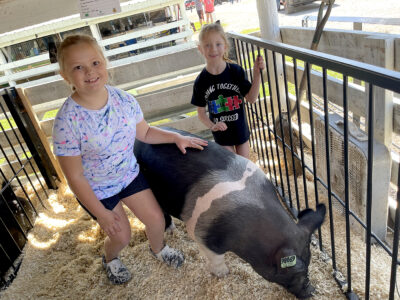Duncombe students explore the science behind music
- -Submitted photo Duncombe Elementary School teacher Karine Feddersen helps students play the ukulele during a recent lesson on the science behind music.
- -Submitted photo Third and fourth graders at Duncombe Elementary School play “Mary Had a Little Lamb” on xylophones during a lesson on the science of music recently.
- -Submitted photo Jason Drew, a paraeducator at Duncombe Elementary School, plays guitar for third and fourth graders during a recent lesson on the science of music.

-Submitted photo Duncombe Elementary School teacher Karine Feddersen helps students play the ukulele during a recent lesson on the science behind music.
The science behind making music can be challenging. Students at Duncombe Elementary School recently found out it can also be fun. Third and fourth graders in math and/or reading extension groups participated in a lesson called “STEAM Investigation: Instruments and Science” to dive deeper into the math and science behind music and sound.
“Not many students take instrumental lessons outside of school, so they all come in with the same amount of background knowledge,” said Karine Feddersen, elementary talented and gifted teacher. “This provided an excellent opportunity to challenge and extend the learning of some of our students beyond the core curriculum in their classrooms.”
The students learned about the families of instruments: brass, percussion, woodwind and strings, by sorting pictures into groups. For this lesson they then focused on the string family. They learned how shapes and vessels make different sounds, the purpose of different parts of the stringed instruments, how to change the pitch of a stringed instrument and the difference between acoustic and electric instruments.
Jason Drew, paraeducator at Duncombe Elementary, played the students a song on his guitar. When asked how he changed the notes in the song, the students responded with, “by moving his fingers to change the combinations” and “by moving one hand while pushing down on the strings with the other.”
Jeremy Pearson, FDCSD director of technology and local musician, talked about acoustic and bass guitars. He explained the acoustic guitar does not need plugged in and is hollow with a hole which lets the sound echo so it can be heard. In contrast, he explained the bass guitar does need plugged in, is not hollow, does not have a hole and must be used with an amplifier for the sound to be heard.

-Submitted photo Third and fourth graders at Duncombe Elementary School play “Mary Had a Little Lamb” on xylophones during a lesson on the science of music recently.
The students learned that the length and thickness of the strings, along with how tight they are pulled determines how high or low the sound is. They also learned that vibration forms the sound wave so the music can be heard.
To demonstrate their learning, the students worked together using their new knowledge to problem solve how to play the tune “Mary Had a Little Lamb” on the ukulele, xylophone and boom whackers.
“This lesson helped challenge the thinking and build on the learning of our students,” Feddersen said. “They enjoyed the struggle of determining how the instruments worked and figuring out how to play the song on the various instruments.”

-Submitted photo Jason Drew, a paraeducator at Duncombe Elementary School, plays guitar for third and fourth graders during a recent lesson on the science of music.







